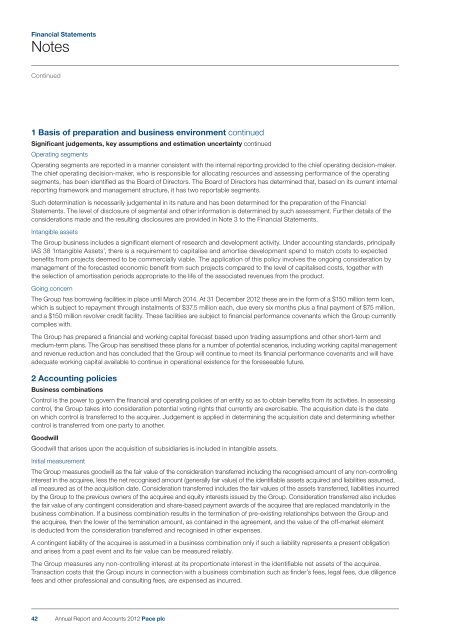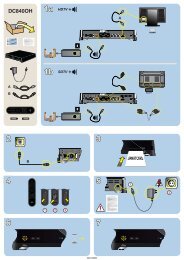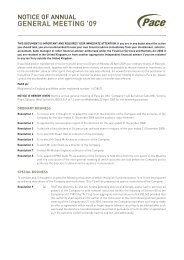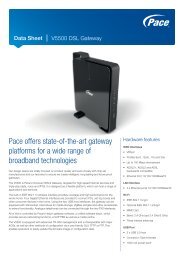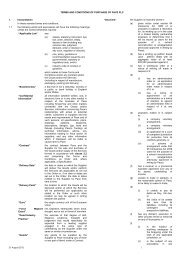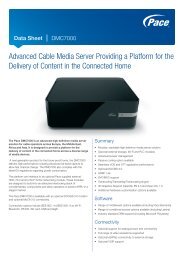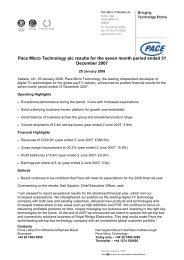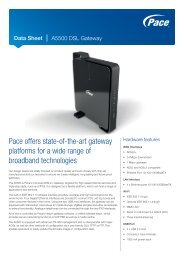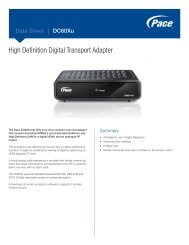Pace plc Annual Report and Accounts 2012 - Financial Statements
Pace plc Annual Report and Accounts 2012 - Financial Statements
Pace plc Annual Report and Accounts 2012 - Financial Statements
Create successful ePaper yourself
Turn your PDF publications into a flip-book with our unique Google optimized e-Paper software.
<strong>Financial</strong> <strong>Statements</strong>NotesContinued1 Basis of preparation <strong>and</strong> business environment continuedSignificant judgements, key assumptions <strong>and</strong> estimation uncertainty continuedOperating segmentsOperating segments are reported in a manner consistent with the internal reporting provided to the chief operating decision-maker.The chief operating decision-maker, who is responsible for allocating resources <strong>and</strong> assessing performance of the operatingsegments, has been identified as the Board of Directors. The Board of Directors has determined that, based on its current internalreporting framework <strong>and</strong> management structure, it has two reportable segments.Such determination is necessarily judgemental in its nature <strong>and</strong> has been determined for the preparation of the <strong>Financial</strong><strong>Statements</strong>. The level of disclosure of segmental <strong>and</strong> other information is determined by such assessment. Further details of theconsiderations made <strong>and</strong> the resulting disclosures are provided in Note 3 to the <strong>Financial</strong> <strong>Statements</strong>.Intangible assetsThe Group business includes a significant element of research <strong>and</strong> development activity. Under accounting st<strong>and</strong>ards, principallyIAS 38 ‘Intangible Assets’, there is a requirement to capitalise <strong>and</strong> amortise development spend to match costs to expectedbenefits from projects deemed to be commercially viable. The application of this policy involves the ongoing consideration bymanagement of the forecasted economic benefit from such projects compared to the level of capitalised costs, together withthe selection of amortisation periods appropriate to the life of the associated revenues from the product.Going concernThe Group has borrowing facilities in place until March 2014. At 31 December <strong>2012</strong> these are in the form of a $150 million term loan,which is subject to repayment through instalments of $37.5 million each, due every six months plus a final payment of $75 million,<strong>and</strong> a $150 million revolver credit facility. These facilities are subject to financial performance covenants which the Group currentlycomplies with.The Group has prepared a financial <strong>and</strong> working capital forecast based upon trading assumptions <strong>and</strong> other short-term <strong>and</strong>medium-term plans. The Group has sensitised these plans for a number of potential scenarios, including working capital management<strong>and</strong> revenue reduction <strong>and</strong> has concluded that the Group will continue to meet its financial performance covenants <strong>and</strong> will haveadequate working capital available to continue in operational existence for the foreseeable future.2 Accounting policiesBusiness combinationsControl is the power to govern the financial <strong>and</strong> operating policies of an entity so as to obtain benefits from its activities. In assessingcontrol, the Group takes into consideration potential voting rights that currently are exercisable. The acquisition date is the dateon which control is transferred to the acquirer. Judgement is applied in determining the acquisition date <strong>and</strong> determining whethercontrol is transferred from one party to another.GoodwillGoodwill that arises upon the acquisition of subsidiaries is included in intangible assets.Initial measurementThe Group measures goodwill as the fair value of the consideration transferred including the recognised amount of any non-controllinginterest in the acquiree, less the net recognised amount (generally fair value) of the identifiable assets acquired <strong>and</strong> liabilities assumed,all measured as of the acquisition date. Consideration transferred includes the fair values of the assets transferred, liabilities incurredby the Group to the previous owners of the acquiree <strong>and</strong> equity interests issued by the Group. Consideration transferred also includesthe fair value of any contingent consideration <strong>and</strong> share-based payment awards of the acquiree that are replaced m<strong>and</strong>atorily in thebusiness combination. If a business combination results in the termination of pre-existing relationships between the Group <strong>and</strong>the acquiree, then the lower of the termination amount, as contained in the agreement, <strong>and</strong> the value of the off-market elementis deducted from the consideration transferred <strong>and</strong> recognised in other expenses.A contingent liability of the acquiree is assumed in a business combination only if such a liability represents a present obligation<strong>and</strong> arises from a past event <strong>and</strong> its fair value can be measured reliably.The Group measures any non-controlling interest at its proportionate interest in the identifiable net assets of the acquiree.Transaction costs that the Group incurs in connection with a business combination such as finder’s fees, legal fees, due diligencefees <strong>and</strong> other professional <strong>and</strong> consulting fees, are expensed as incurred.42<strong>Annual</strong> <strong>Report</strong> <strong>and</strong> <strong>Accounts</strong> <strong>2012</strong> <strong>Pace</strong> <strong>plc</strong>


